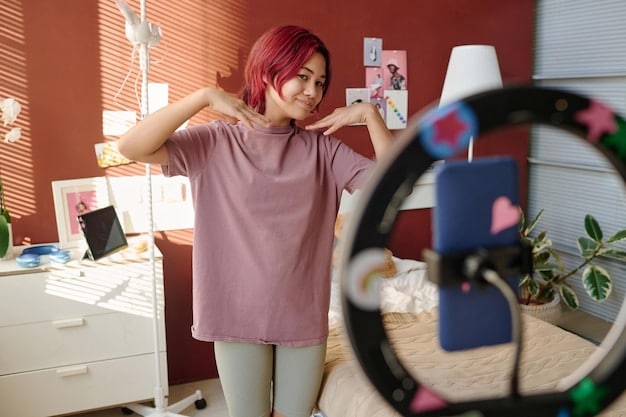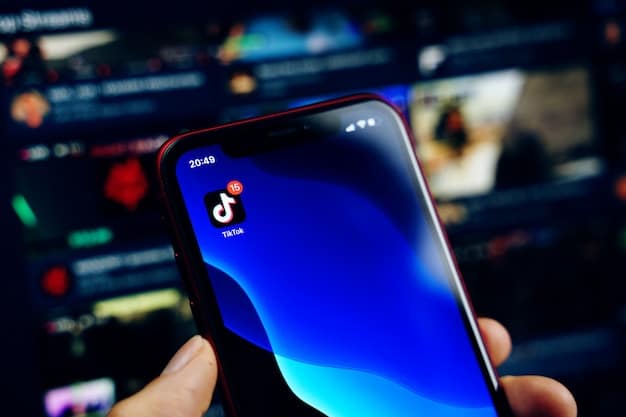TikTok Influencer Collaboration: Negotiate Rates & Partnerships for 2025

Negotiating effective rates and securing successful partnerships with TikTok influencers for 2025 campaigns requires a strategic approach, involving market research, clear communication, performance-based incentives, and adaptable contract terms to maximize ROI and align with evolving trends.
Navigating the world of TikTok influencer collaboration: negotiate rates and secure partnerships for 2025 campaigns can be challenging, but with the right strategies, it’s possible to strike deals that benefit both your brand and the influencer. Understanding market trends, setting clear expectations, and crafting mutually beneficial agreements are key to success.
Understanding the TikTok Influencer Landscape for 2025
The TikTok influencer landscape is constantly evolving. Staying informed about the latest trends, popular creators, and audience demographics is crucial for identifying the right partners for your brand. Let’s dive into what you need to know for successful collaborations in 2025.
Identifying Key Trends
Keep a close eye on emerging content formats, trending challenges, and the types of influencers that are resonating with audiences. Analyzing what’s working for other brands in your industry can provide valuable insights.
- Pay attention to niche communities and micro-influencers for targeted campaigns.
- Track the performance of different content styles, such as duets, stitches, and live streams.
- Monitor algorithm changes and adapt your strategy accordingly.
Finding the Right Influencers
Finding influencers that align with your brand’s values and target audience is essential. Look beyond follower count and focus on engagement rate, authenticity, and content quality.

- Use influencer marketing platforms to search for creators based on demographics, interests, and past performance.
- Analyze their content to ensure it aligns with your brand’s message and values.
- Reach out to influencers with personalized messages that demonstrate your understanding of their work.
Ultimately, understanding the TikTok influencer landscape is about staying agile and adapting to the platform’s ever-changing dynamics. By doing your research and carefully selecting your partners, you can set the stage for successful collaborations.
Setting Clear Objectives and Defining Your Campaign Goals
Before reaching out to potential influencers, it’s important to establish clear objectives and define your campaign goals. What do you hope to achieve through your TikTok influencer collaborations?
Defining Measurable Metrics
Establish key performance indicators (KPIs) to measure the success of your campaigns. These metrics should be specific, measurable, achievable, relevant, and time-bound (SMART).
- Increase brand awareness by tracking impressions and reach.
- Drive website traffic by monitoring click-through rates (CTR).
- Generate leads by analyzing conversion rates.
Aligning Goals with Influencer Expertise
When selecting influencers, consider their expertise and how it aligns with your campaign goals. Some influencers may excel at creating engaging video content, while others may have a strong track record of driving sales.
Consider using TikTok influencer collaboration with creators who have a passion for your niche, as this will lead to more authentic and engaging content for their followers.
By setting clear objectives and defining your campaign goals, you can ensure that your TikTok influencer collaborations are aligned with your overall marketing strategy and contribute to your bottom line.
Researching Influencer Rates: Benchmarks and Industry Standards
Determining fair rates for TikTok influencer collaborations can be tricky. Researching benchmarks and industry standards is a crucial first step.
Factors Influencing Rates
Several factors can influence influencer rates, including follower count, engagement rate, content quality, and the scope of the campaign. Understanding these factors can help you negotiate effectively.
- Follower count is a common starting point, but engagement rate is a better indicator of an influencer’s reach and impact.
- Content quality affects the value of a collaboration. High-quality content increases brand awareness and drives conversions.
- The scope of the campaign includes the number of posts, type of content, and exclusivity rights.
Using Rate Calculators and Tools
Several online rate calculators and tools can help you estimate fair rates for TikTok influencers. These tools typically take into account factors such as follower count, engagement rate, and industry benchmarks.

Some tools that assist with TikTok influencer collaboration rates include Social Blade and Influencer Marketing Hub’s Rate Calculator; they can give useful insights into industry benchmarks.
Researching influencer rates is an ongoing process. Market dynamics and inflation can affect rates. By familiarizing yourself with the various factors that influence rates, you can negotiate effectively and find the right influencers for your budget.
Negotiating Rates: Strategies for Securing Favorable Deals
Once you have a good understanding of influencer rates, it’s time to start negotiating. Your negotiation strategy will depend upon how the TikTok influencer collaboration process is going and will vary according to influencer.
Value-Based Negotiation
Focus on the value that the influencer brings to your brand. Highlight the benefits of the collaboration, such as increased exposure, brand recognition, and opportunities for future partnerships.
Performance-Based Incentives
Consider offering performance-based incentives to align the influencer’s goals with your campaign objectives. This could include bonuses for achieving specific milestones, such as reaching a certain number of impressions or driving a certain amount of sales.
Some influencers respond well when there are transparent Key Performance Indicators (KPIs) for their TikTok influencer collaboration. This can include metrics around clicks, impressions, or sales.
Building Long-Term Relationships
Think beyond the immediate campaign and focus on building long-term relationships with influencers. Offering them opportunities to collaborate on future projects can help you secure favorable rates and foster a sense of loyalty.
Ultimately, negotiating rates is about finding a mutually beneficial agreement that works for both your brand and the influencer. Be prepared to be flexible and willing to compromise, while staying true to your budget and campaign goals.
Crafting Partnership Agreements: Legal and Contractual Considerations
A well-crafted partnership agreement is essential for ensuring that both parties understand their rights, responsibilities, and obligations. Legal and contractual considerations include defining the scope of work, payment terms, and intellectual property rights.
Defining the Scope of Work
Clearly outline the scope of work in the partnership agreement. This should include the number of posts, type of content, posting schedule, and any exclusivity requirements.
Payment Terms and Schedules
Specify the payment terms, including the amount, payment schedule, and accepted payment methods. It’s also important to address any potential penalties for non-compliance.
Intellectual Property Rights
Address intellectual property rights in the partnership agreement. This should clarify who owns the content created during the collaboration and how it can be used in the future.
In the process of TikTok influencer collaboration, be sure to check local regulations regarding what disclosures need to be made so that your influencer doesn’t get into any legal trouble.
By addressing these legal and contractual considerations in your partnership agreement, you can minimize the risk of disputes and ensure that both parties are protected.
Measuring Campaign Performance and Analyzing ROI
Measuring campaign performance and analyzing ROI are essential for determining the effectiveness of your TikTok influencer collaborations. Tracking the right metrics can help you optimize your strategy.
Tracking Key Metrics
Track key metrics such as impressions, reach, engagement rate, website traffic, and conversion rates to measure the performance of your campaigns. Use analytics tools to monitor these metrics.
Analyzing ROI
Analyze the return on investment (ROI) of your campaigns by comparing the cost of the collaboration to the revenue generated. Use data to optimize your campaigns for better results.
When looking at TikTok influencer collaboration, you should also consider less tangible things like an increased loyalty from specific demographics. This can be hard to measure and will take time analytics-wise to determine.
By measuring campaign performance and analyzing ROI, you can gain valuable insights into what’s working and what’s not. Use this data to continually refine your strategy and maximize your returns.
| Key Point | Brief Description |
|---|---|
| 🔍 Research Trends | Stay updated on the latest TikTok trends to identify relevant influencers. |
| 🎯 Define Objectives | Set clear, measurable goals for your TikTok influencer collaboration campaign. |
| 🤝 Negotiate Rates | Offer value and consider performance-based incentives for favorable deals. |
| 📝 Agreement | Always use proper legal paperwork when doing TikTok influencer collaboration. |
Frequently Asked Questions About TikTok Influencer Collaboration
Follower count, engagement rate, content quality, and campaign scope all influence rates. Engagement rate and content relevance are better indicators of a good influencer than the number of followers.
Focus on the value the influencer brings. Offer performance-based incentives and build long-term relationships for more favorable deals and better TikTok influencer collaboration.
Include the scope of work, payment terms, deliverables, usage rights, and termination clauses to ensure both parties are protected, along with local guidance around appropriate disclaimers.
Track impressions, reach, engagement rate, website traffic, and conversion rates. Analyze ROI to determine the effectiveness and improve future campaigns and overall TikTok influencer collaboration success.
Ignoring engagement metrics, not setting clear objectives, and failing to create a comprehensive partnership agreement are common mistakes. Also, not doing due diligence on influencer background.
Conclusion
Mastering the art of TikTok influencer collaboration in 2025 requires a blend of research, negotiation, and strategic planning. By understanding the influencer landscape, setting clear goals, and crafting mutually beneficial agreements, you can unlock the full potential of TikTok for your brand.






